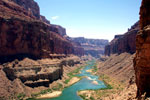The UN-backed Collaborative Partnership on Forests (CPF) is urging nations to conserve their forests in a bid to mitigate rising water scarcity problems.
“[Forests] reduce the effects of floods, prevent soil erosion, regulate the water table and assure a high-quality water supply for people, industry and agriculture,” said the Forestry Department Assistant Director General, Eduardo Rojas-Briales, with the UN Food and Agriculture Organization (FAO). “Forests are part of the natural infrastructure of any country and are essential to the water cycle.”
In addition, forests reduce the impact of droughts, while preventing desertification and salinization, while loss of tropical rainforests has been shown to decrease local rainfall. In addition, cutting-edge research has even established a link between forest cover and winds delivering rainfall, one that remains quite controversial.
“The management of water and forests are closely linked and require innovative policy solutions which take into account the cross-cutting nature of these vital resources”, Jan McAlpine, Director of the UN Forum on Forests Secretariat, said.
According to the UN, one-third of the world’s largest cities depend on forested areas for their water.
Fresh water scarcity is becoming an increasingly alarming problem as sources are polluted, consumption rises, and climate change impacts water availability due to glacier melt and desertification. According to the UN, within 15 years 1.8 billion people could suffer from ‘absolute water scarcity’, while two-thirds of the global population could see water scarcities. Currently, 20% of people in the developing world don’t have access to clean water.
The UN has declared 2011 the International Year of Forests.
Related articles
Protecting forests can cut water filtration costs
(03/04/2011) Clean water doesn’t come cheap. Communities and businesses often rely on expensive water filtration infrastructure to ensure their clean water supplies. But communities around the world have been protecting upstream forests instead of building new, costly water treatment infrastructure. Can this strategy work in the US south?
Groundbreaking research shows that rainforests and coral reefs create rainfall #BAD10
(10/15/2010) Coral reefs and rainforests seem to have little in common beyond the fact that they are both hotspots of diversity, yet groundbreaking research is showing how these different ecosystems—when intact—may actually seed clouds and produce rainfall.
Rivers worldwide in peril: society treats symptoms, ignores causes

(09/29/2010) Dams, agricultural runoff, pesticides, sewage, mercury pollution from coal plants, invasive species, overconsumption, irrigation, erosion from deforestation, wetland destruction, overfishing, aquaculture: it’s clear that the world’s rivers are facing a barrage of unprecedented impacts from humans, but just how bad is the situation? A new global analysis of the world’s rivers is not comforting: the comprehensive report, published in Nature, finds that our waterways are in a deep crisis which bridges the gap between developing nations and the wealthy west. According to the study, while societies spend billions treating the symptoms of widespread river degradation, they are still failing to address the causes, imperiling both human populations and freshwater biodiversity.